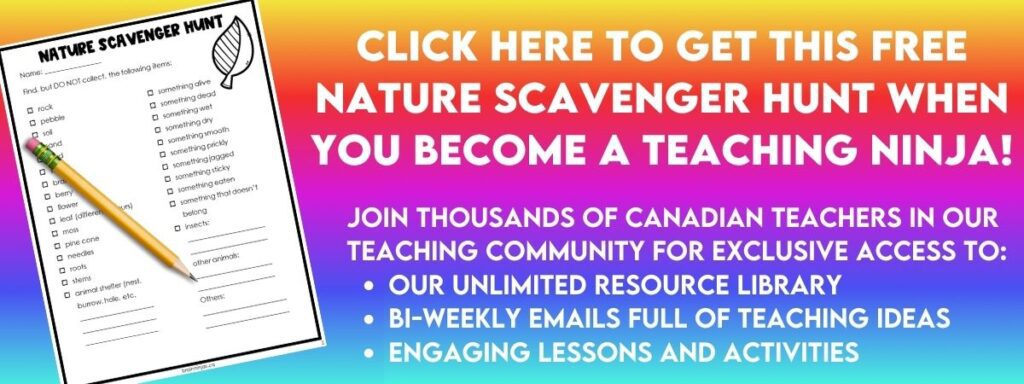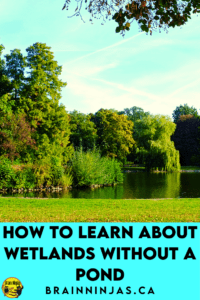
Teaching students about wetlands can be a real challenge when you don’t have access to a pond or field trips to go to a pond. Each year in Canada, we struggle with winter sneaking well into spring, shortening the time available to teach the unit outdoors. If we try to teach the unit in the fall, we often end up with snow within a few weeks of starting the unit. So how are students supposed to learn about wetlands when they can’t actually get to a wetland?
We typically teach the unit in the fall or the spring since these are the only two times of year where we don’t have snow. Some years field trips haven’t been an option for a variety of different reasons, so we’ve had to improvise before.
If you’re looking for a shortcut, you can grab our wetlands bundle. It’s designed to teach students in Canada about wetlands, so it doesn’t include any information about alligators or flamingos. Find it on TpT ($USD) or our BN Shop ($CAN).
Learn About Wetlands Outside
We start our unit by taking a walk. This is a simple activity, doesn’t require any supplies and doesn’t have to take a long time. If you have a nearby community park or a field nearby with some trees, you’ll have everything you need.
Biotic and Abiotic Interactions
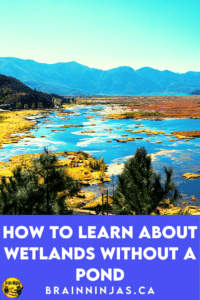
Once outside, ask students to make a list of things they see. Have them call out everything they can see and include things like branches, leaves on the ground, grass, dirt, rocks, the sky and the sun. Ask students to call out things that are alive. Hopefully, they can identify people, birds or plants like grass and trees. Ask students to call out things that are not alive. This one might be more difficult. If they don’t get it, talk about the sunlight, the air and the rocks. Explain the difference between abiotic (things that do not and have never lived) and biotic things (things that are alive or were alive and are now dead).
Now ask your students to walk around pointing out abiotic and biotic things. They’ve just been able to learn about wetlands without a pond.
This activity is included in our Biotic and Abiotic Interactions lessons along with several others. It can also be purchased in a bundle. The lesson goes into more detail about the relationships between biotic and abiotic factors.
If you’d like to do a bit of a scavenger hunt while outside, try our Nurturing Nature Activity. It’s available for free in our Resource Library or we can send it to you when you sign up to be on our email list.
Do Hands-On Lessons When Possible
Bring a Pond
As a student, I remember my seventh grade teacher bringing a swimming pool full of pond water. We studied the water looking for microscopic creatures. As engaging as it was, I don’t recommend it.
Instead, think about bringing a small pond in a jar. Giant pickle jars make great little temporary ponds. You need to leave the top open to allow any microscopic creatures in the water to survive. Only keep the water for a day or two and return it to the pond when your class has finished observing it.
Avoid capturing any water creatures like tadpoles or insect larva.
If you have access to a small aquarium, it works great too. Do not leave your aquarium in the sun as the water may get too warm.
Visit and Photograph Local Wetlands
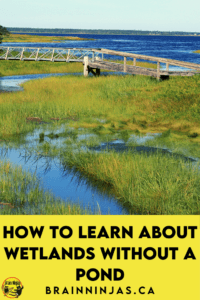
Visit a wetland area on your own and start building a collection of images. We have found that collecting photographs is one way to show students certain aspects of wetlands. Encourage your students and their families to visit provincial or national parks with wetlands and take pictures that can be shared with the class.
We have started to take video, trying to capture some of the sounds of the birds. We have many photos and videos in our collection and visit different sites to capture the changes over the seasons. Set up a Google Drive Folder where can always have access to your photos.
Visit Local Wetlands Virtually
Talk about the different wetland areas where you live. Many parks have websites or can be visited virtually through Google Maps. This is a great way to see photographs or overviews of wetland areas that are nearby.
Some of the parks in Alberta have their own websites, but we’ve had the most success with Ducks Unlimited. You can search by province and find ones near you.
Use Classroom Lessons
There are lots of preplanned lessons about wetlands out there on the web. We found that most of it wasn’t relevant to Canada because it included animals and plants that are not native to the area. That’s why we started creating these lessons.
Types of Wetlands
It can be challenging to showcase different types of wetlands if your local area only has one type. We create different activities where students gather information about each type of wetland and then create anchor charts about the different characteristics.
Some of this research is done online by students and some we give them in our Types and Descriptions of Wetlands lessons. We also found a good website to gather background information for teachers. It’s a little above the reading level of upper elementary, but it does have some helpful diagrams.
Wetlands Around the World
There are different types of wetlands depending on the part of the world. To help our students better understand this, we created a few lessons to teach Wetlands Around the World. We wanted students to understand that wetlands are a geographical feature.
Plant Zones

It can be challenging to learn about wetlands without understanding how their characteristics determine the plants and animals that will live in the area. Before explaining the different types of zones where plants can grow, try this activity.
Fill a clear square tub half full of water. This does not need to be a big container, but it works better if students can see through the side of the container. The size of an ice cream pale works well. Tape a straw to the side of the container so that the top sticks out of the water and the other end touches the bottom. Place a rock (sinks) a piece of foam (floats) into the container.
Ask students to explain how this visual diagram relates to wetlands. If they don’t figure it out right away, ask them to imagine that each of the items is a plant. Hopefully, they know enough about wetlands to think about the different levels of water. You might have to just directly teach the concept, but the visual is a good way to see what is meant by each plant zone.
We created a template as part of our Plant Zones Lessons. It helped teach students about floating plants (ones where the majority of the plant floats on top of the water), emergent plants (plants where the roots are in the ground underwater) and submergent plants (where almost all of the plant is underwater).
Roles of Wetlands
Many people do not truly understand the purpose of wetlands. In fact, a family member once commented that their only purpose was to attract mosquitoes. Before studying all the things wetlands do or what can happen without wetlands, I kind of agreed.
Wetlands don’t just provide habitats for thousands of plants, animals and insects. While this is important, they also protect humans by absorbing carbon, filtering water and reducing greenhouse gases.
To help our students understand the importance of wetlands we wrote lessons about the Roles of Wetlands and Threats and Conservation lessons. They focus on understanding the different reasons we need wetlands and how we can help protect them.
Adaptations of Plants and Animals in Wetlands
This is one of our favourite concepts to teach because it means students can be a little more creative. After learning about different adaptations, we have students create their own plants or animals and describe their adaptations. Students love the chance to show off what they’ve learned in a creative way. You can get all the materials to teach the concept, practice, do the project and assess it in our Physical and Behavioural Adaptations set.
Life Cycles, Food Webs and Food Chains
To understand more about the life cycles of plants and animals in the wetlands, we drew a whole bunch of diagrams and templates that can save you a lot of time researching. Grab the Life Cycles set.
We have done lots of different activities over the years regarding food webs and chains. Our students have enjoyed these the most.
Before starting this lesson, ask your students to collect pictures of plants and animals that might appear in wetlands. We cut out pictures from magazines. Students brought in pictures from home that we photocopied and we tagged pictures in books with sticky notes and made photocopies. We used all these pictures to make a massive food web on the wall of our classroom. Students loved making all the connections.
For a digital version, we asked students to find pictures online and paste them into a Google Slide file. They added arrows to show the transfer of energy. This activity makes a great quick assessment, too.
If you’re looking for more lessons related to food chains, food webs and the different stages in food chains like decomposers, consumers and producers we have several activities in our Organisms and Food Chains set.
Use Support Materials to Learn About Wetlands
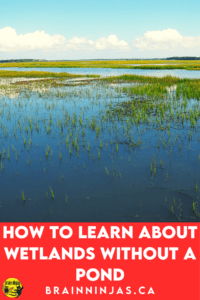
There are no textbooks available and many websites are at a university reading level. To help with this, we wrote a set of reading passages covering all the outcomes for the unit so that our students could be supported and fill in any missing background information while learning about wetlands.
To have a little fun reviewing everything we’ve learned in our unit, we play this interactive game. It’s perfect for a quick review.
All of the lessons listed above are included in our Wetlands Bundle which is discounted.
Add Science to Your Language Arts
When you include science concepts in other lessons, it helps deepen the connections to the content. We wrote reading passages for language arts and included specific lessons about text features, word parts and parts of speech. Each topic is one week of Language Arts. This set has a wetlands theme and was designed for a Grade 5 reading level.
Busy Beavers on TpT ($USD) or our BN Shop ($CAN)
Making Wetlands on TpT ($USD) or our BN Shop ($CAN)
Uses of Peat on TpT ($USD) or our BN Shop ($CAN)
Urbanization on TpT ($USD) or our BN Shop ($CAN)
Or grab all four weeks in the Wild Wetlands bundle on TpT ($USD) or our BN Shop ($CAN). This bundle is one of our Weekly Reading Comprehension Sets. You can find all of our Weekly Reading Comprehension Sets on TpT ($USD) or our BN Shop ($CAN).
Do You Teach Science?
We have written other posts about many science topics.
- Engaging Electricity Lessons to Shock Your Students
- How to Grow a Healthy Classroom with Plants
- Engaging Weather Lessons All In One Place
How Do Your Students Learn About Wetlands?
We are always on the lookout for more ways to teach our students about wetlands. If you have a genius idea, we’d love to hear about it.

